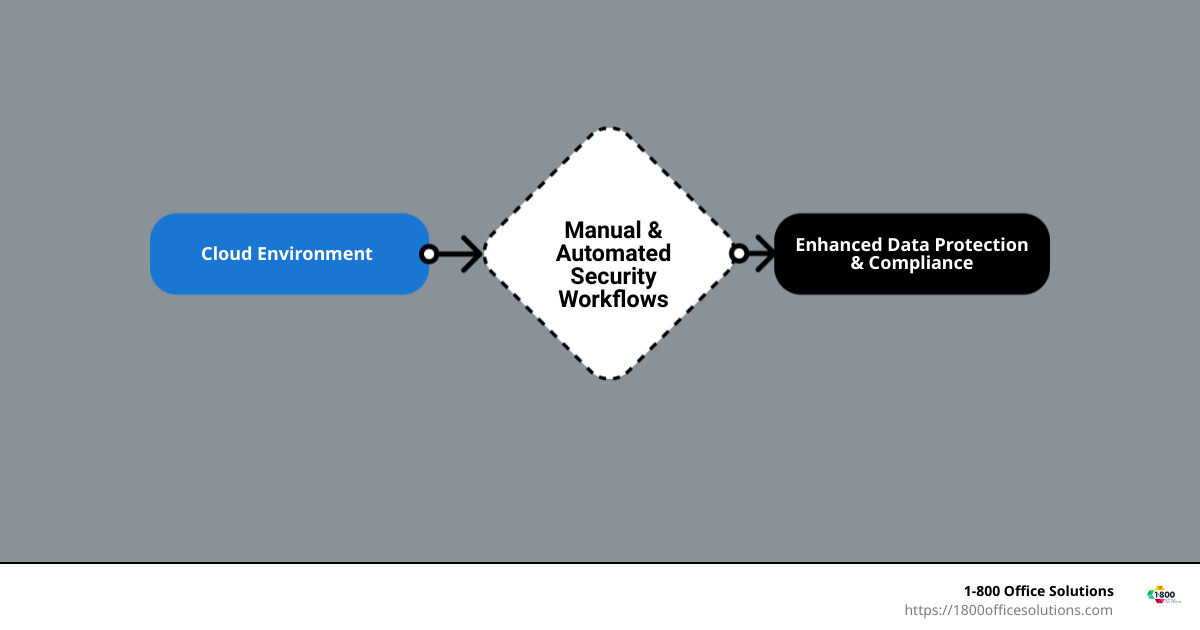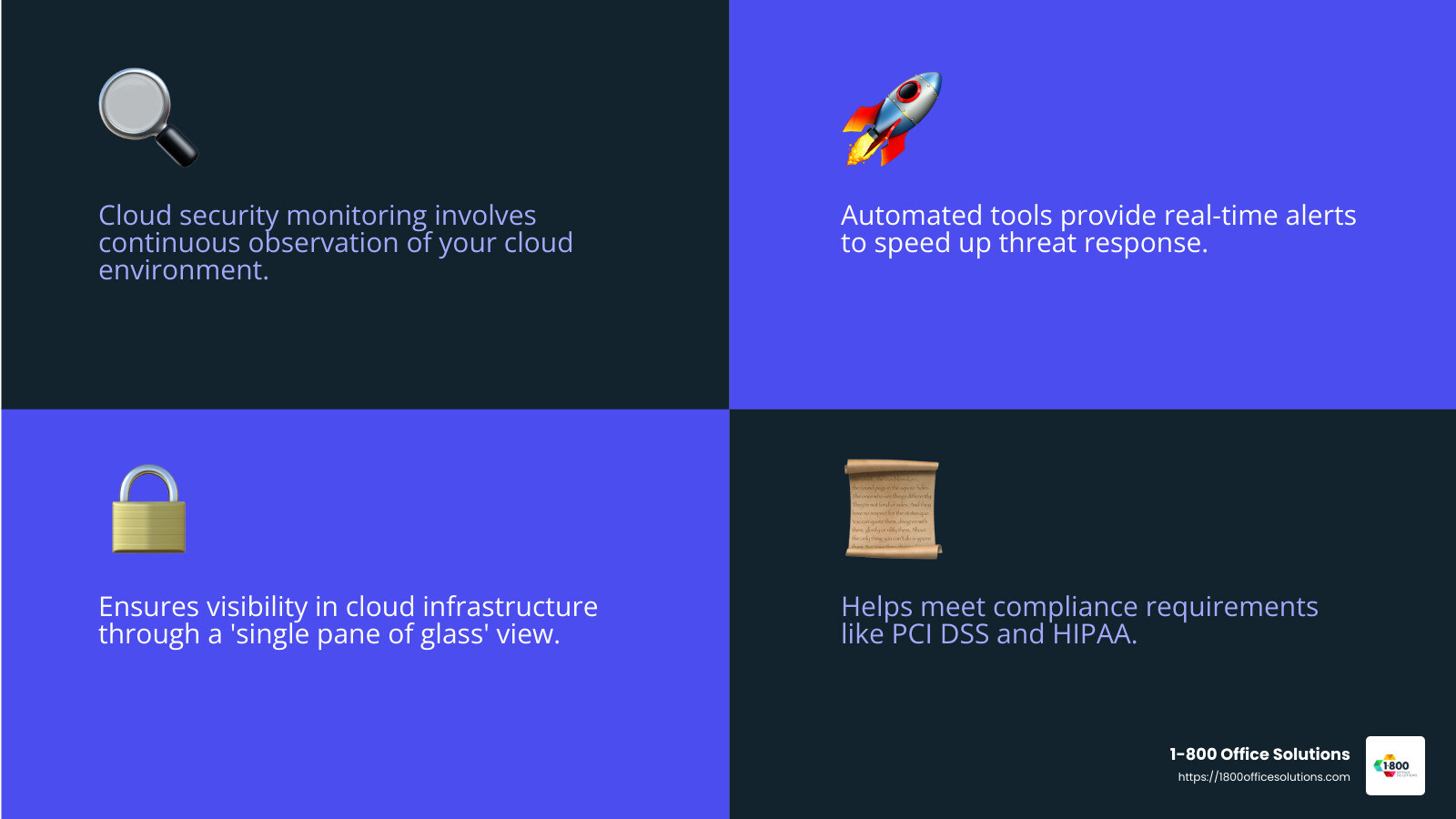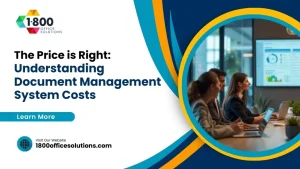Cloud Security Monitoring: Your Guide to a Safer Cloud
Cloud security monitoring is the process of reviewing, managing, and observing security workflows in a cloud environment. For those seeking a quick glimpse, here’s a nutshell view:
- Protects data, applications, and infrastructure in the cloud
- Uses both manual and automated methods to spot potential security issues
- Aids in maintaining compliance with regulations (like PCI DSS, HIPAA)
- Helps identify and quickly resolve vulnerabilities
- Supports continuous monitoring for better threat detection
Businesses increasingly rely on cloud computing for both efficiency and scalability. However, this shift brings new challenges, like ensuring data security and compliance. This is where cloud security monitoring steps in, offering more visibility and keeping your sensitive data safe, all while minimizing downtime.

Handy cloud security monitoring terms:
Understanding Cloud Security Monitoring
Cloud security monitoring is an essential process that helps organizations keep their cloud environments safe and compliant. It combines both manual and automated processes to ensure comprehensive coverage and protection.
The Processes Involved
At its core, cloud security monitoring involves continuous observation of your cloud environment. This means keeping an eye on all activities, data flows, and configurations within your cloud infrastructure. The goal? To detect and address threats before they become serious issues.
- Manual Processes: These involve human oversight and intervention. Security experts regularly review alerts, logs, and reports to identify potential threats. They bring their expertise to analyze complex situations that automated tools might miss.
- Automated Processes: Automation plays a significant role in cloud security monitoring. Tools like AWS CloudWatch and third-party solutions automatically track and assess security metrics. They provide real-time alerts for immediate action, reducing the time it takes to respond to threats.
Visibility and Compliance
Visibility is crucial in a cloud environment. Moving to the cloud can obscure certain aspects of your infrastructure, making it harder to see what’s happening. Cloud security monitoring tools offer a “single pane of glass” view, allowing you to see everything in one place—from user activities to application behaviors.
Being compliant with industry regulations like PCI DSS and HIPAA is non-negotiable. These regulations often require continuous monitoring to ensure data protection standards are met. Cloud security monitoring helps organizations meet these compliance requirements, avoiding costly penalties.

Why It Matters
When data breaches and cyber threats are increasingly common, cloud security monitoring is not just a nice-to-have—it’s a must-have. By leveraging both manual oversight and automated tools, organizations can maintain a strong security posture, ensuring that their data, applications, and infrastructure remain safe and compliant.
This comprehensive approach not only protects sensitive information but also supports business continuity by minimizing downtime and disruptions.
In the next section, we’ll explore the key components that make cloud security monitoring effective and efficient.
Key Components of Cloud Security Monitoring
To effectively safeguard your cloud environment, certain key components are essential. Let’s break them down:
Continuous Monitoring
Continuous monitoring is like having a security guard who never sleeps. It involves keeping a constant watch over your cloud systems to detect any unusual activity or potential threats. This 24/7 vigilance is crucial for early threat detection and quick response. By continuously monitoring, you can significantly reduce the time between threat detection and remediation, thus minimizing potential damage.
Scalability
As your business grows, your cloud environment will likely expand too. Scalability in cloud security monitoring means your security measures can grow with your needs. Traditional monitoring tools might struggle with increased workloads, but scalable solutions ensure that every part of your cloud system is covered, regardless of size. This adaptability is vital to maintain comprehensive security as your cloud infrastructure evolves.
Integration
Integration is about making sure your cloud security tools work well with each other and with your existing systems. The more integrated your tools are, the more seamless and efficient your monitoring will be. This means fewer gaps in coverage and a more unified approach to security. When your monitoring tools can communicate and share data effectively, it improves your overall security posture.
Auditing
Regular auditing is like a health check-up for your cloud environment. It involves reviewing your security measures, processes, and configurations to ensure they are effective and compliant. Audits help identify vulnerabilities and areas for improvement. They are essential for maintaining compliance with industry standards and regulations, such as PCI DSS and HIPAA. By conducting routine audits, you can ensure that your security practices are up-to-date and robust.
Each of these components plays a critical role in creating a strong and effective cloud security monitoring strategy. By focusing on continuous monitoring, scalability, integration, and auditing, organizations can better protect their cloud environments against threats and ensure compliance with industry standards.
In the next section, we’ll dive into the benefits of cloud security monitoring and why it’s a crucial part of any cloud strategy.
Benefits of Cloud Security Monitoring
When it comes to cloud security monitoring, the benefits are substantial. Let’s explore why this practice is crucial for your organization:
Compliance
Staying compliant with industry regulations is not optional; it’s mandatory. Regulations like PCI DSS and HIPAA require continuous monitoring to ensure data security. By leveraging cloud security monitoring tools, organizations can meet these compliance requirements effortlessly. This not only helps avoid hefty fines but also builds trust with customers and partners.
Vulnerability Identification
Imagine having a radar that spots vulnerabilities before they become threats. That’s what cloud security monitoring does. It provides visibility into your cloud environment, enabling you to identify weaknesses and potential risks. Automated tools can quickly alert your IT and security teams to any anomalies, allowing for swift action to prevent security breaches.
Business Continuity
Security incidents can disrupt operations and damage your reputation. With effective cloud security monitoring, you can maintain business continuity. By identifying threats early and responding promptly, you minimize the risk of disruptions. This ensures that your business runs smoothly, even in the face of potential cyber threats.
Data Protection
Protecting sensitive data is paramount. Cloud security monitoring helps you perform regular audits and keep your data secure. It monitors the health of your security systems and provides recommendations for enhancing data protection measures. By safeguarding your data, you maintain customer trust and protect your organization’s most valuable assets.
Each of these benefits highlights the importance of integrating cloud security monitoring into your organization’s strategy. By maintaining compliance, identifying vulnerabilities, ensuring business continuity, and protecting data, you can create a safer and more secure cloud environment.
In the next section, we’ll address the challenges that can arise in cloud security monitoring and how to overcome them.
Challenges in Cloud Security Monitoring
While cloud security monitoring offers numerous benefits, it also comes with its own set of challenges. Let’s dig into some of the most common obstacles organizations face and explore strategies to overcome them.
Alert Fatigue
Security teams often experience “alert fatigue” due to an overwhelming number of notifications. This happens when monitoring tools generate excessive alerts, many of which may not be critical. The result? Important warnings might get lost in the noise.
To combat this, organizations should prioritize alerts based on risk. Implementing smarter filtering systems and leveraging AI-driven tools can help distinguish between critical and non-critical events. This reduces noise and ensures that the team focuses on genuine threats.
Lack of Context
Without context, alerts and logs are just noise. Security teams need to understand what they are monitoring and why. Contextual awareness is crucial for interpreting alerts and taking appropriate action.
Using advanced threat detection platforms that offer remediation steps and playbooks can provide the necessary context. By understanding the bigger picture, teams can respond more effectively to potential threats.
Strategy and Planning
Many organizations rush into cloud adoption without a clear cloud security strategy. This can lead to gaps in security and oversight. Key stakeholders must address crucial questions like:
- How do we track changes in cloud policies?
- How do we manage asset visibility and access?
A well-defined strategy is essential. It should encompass visibility, asset management, and data protection. Only then can organizations fully leverage the benefits of cloud security monitoring.
In cloud environments, security responsibilities are shared between the provider and the customer. This model can lead to confusion about who is responsible for what, resulting in security gaps.
Clear communication and understanding of the shared responsibility model are vital. Organizations must ensure they know which aspects of security they are responsible for and take appropriate measures to address them. Working closely with cloud providers to clarify roles can help mitigate this challenge.
By acknowledging these challenges and implementing effective strategies, organizations can improve their cloud security monitoring efforts. In the next section, we’ll outline best practices to ensure your monitoring efforts are both effective and efficient.
Best Practices for Effective Cloud Security Monitoring
To make the most of cloud security monitoring, it’s crucial to follow some best practices. These strategies help ensure that your security efforts are both effective and efficient. Let’s explore key practices such as context-aware alerting, automation, real-time anomaly detection, and multi-cloud integration.
Context-Aware Alerting
Alerts without context can lead to confusion and missed threats. Context-aware alerting helps prioritize notifications based on user roles, past behavior, and resource sensitivity. For example, an alert about admin-level account misuse should take precedence over a lower-risk event.
By focusing on the context, security teams can better understand the significance of alerts and respond more effectively. This approach reduces noise and ensures the team can focus on the most critical threats.
Automation
Automation is key to managing the complexity of cloud environments. Automated incident response using predefined playbooks can quickly address common cloud threats. This means repetitive tasks, like isolating compromised instances or blocking malicious users, happen instantly without human intervention.
Using tools like SIEM or XDR platforms, organizations can automate routine security tasks. This allows security teams to focus on more strategic initiatives while maintaining real-time vigilance.
Real-Time Anomaly Detection
Detecting unusual activities as they happen is crucial for preventing security incidents. Real-time anomaly detection involves using continuous behavioral analytics to spot deviations from normal activity patterns.
This practice is essential for catching insider threats, credential abuse, or unauthorized resource deployments before they escalate. By identifying anomalies early, organizations can mitigate risks swiftly and effectively.
Multi-Cloud Integration
Many organizations use multiple cloud providers, which can complicate security monitoring. Multi-cloud integration helps consolidate logs and security data across different platforms, providing a unified view of the entire cloud ecosystem.
Choosing monitoring tools that seamlessly integrate across multiple cloud providers ensures comprehensive oversight. This integration is vital for detecting cross-cloud attack patterns and ensuring no gaps in security coverage.
By implementing these best practices, organizations can improve their cloud security monitoring efforts and better protect their cloud environments. In the next section, we’ll address frequently asked questions about cloud security monitoring to further clarify this important topic.
Frequently Asked Questions about Cloud Security Monitoring
Understanding cloud security monitoring can be complex. Here, we answer some common questions to help you grasp how it works and what it covers.
How does cloud security monitoring work?
Cloud security monitoring combines manual and automated processes to keep your cloud environment safe. It involves continuously supervising both virtual and physical servers to detect threats and vulnerabilities. Tools automatically collect and analyze log data across servers, applications, and networks. When they spot unusual activity, they send alerts to security teams, enabling quick incident response and remediation.
Automation plays a key role here. For example, if a system detects a potential breach, automated processes can isolate the threat immediately, reducing the risk of damage.
What are the main areas assessed in cloud monitoring?
Cloud monitoring focuses on three main areas: performance, security, and compliance.
- Performance: Ensures cloud resources are running efficiently and effectively. This includes monitoring load times, response rates, and resource usage.
- Security: Looks for potential threats and vulnerabilities. This includes checking for unauthorized access, malware, and suspicious activity.
- Compliance: Ensures that cloud operations meet regulatory standards like PCI DSS and HIPAA. Compliance monitoring helps avoid penalties and maintain trust.
What are common cloud security risks?
Cloud environments come with their own set of security challenges. Here are some common risks:
- Misconfigurations: Often due to human error, misconfigurations can leave cloud resources exposed. A famous example is the Capital One breach in 2019, where a misconfigured web application firewall led to a massive data leak.
- Data Loss: The ease of sharing data in the cloud can lead to accidental exposure. According to Synopsys’ Cloud Security Report, 64% of cybersecurity professionals cite data loss as a top concern.
- API Vulnerabilities: APIs are crucial for cloud applications but can be exploited if not secured properly. Attackers can use them to launch denial-of-service attacks or access sensitive data.
By understanding these risks, organizations can implement better security measures and protect their cloud environments more effectively.
Secure, Compliant Cloud Environments with 1-800 Office SolutionsConclusion
1-800 Office Solutions is here to help you steer the complexities of cloud security. As a leader in the office solutions industry, we offer comprehensive managed IT services that prioritize your security needs.
Our cloud security solutions are designed to keep your business safe and compliant, ensuring that you can operate without interruptions. Whether you’re in Orlando, Chicago, or any of our other locations, our team is ready to support your journey to a safer cloud environment.
Protecting your data and maintaining business continuity is crucial. Our services provide the robust security measures needed to safeguard sensitive information against threats like misconfigurations and data breaches. We integrate cloud security monitoring into your IT strategy to offer real-time threat detection and response, helping you stay ahead of potential risks.
With our expertise, you can focus on what you do best—running your business—while we take care of your IT security needs. By choosing 1-800 Office Solutions, you’re not just investing in technology; you’re investing in peace of mind.
Explore our cloud security solutions to learn how we can help you achieve a safer, more secure cloud environment.











